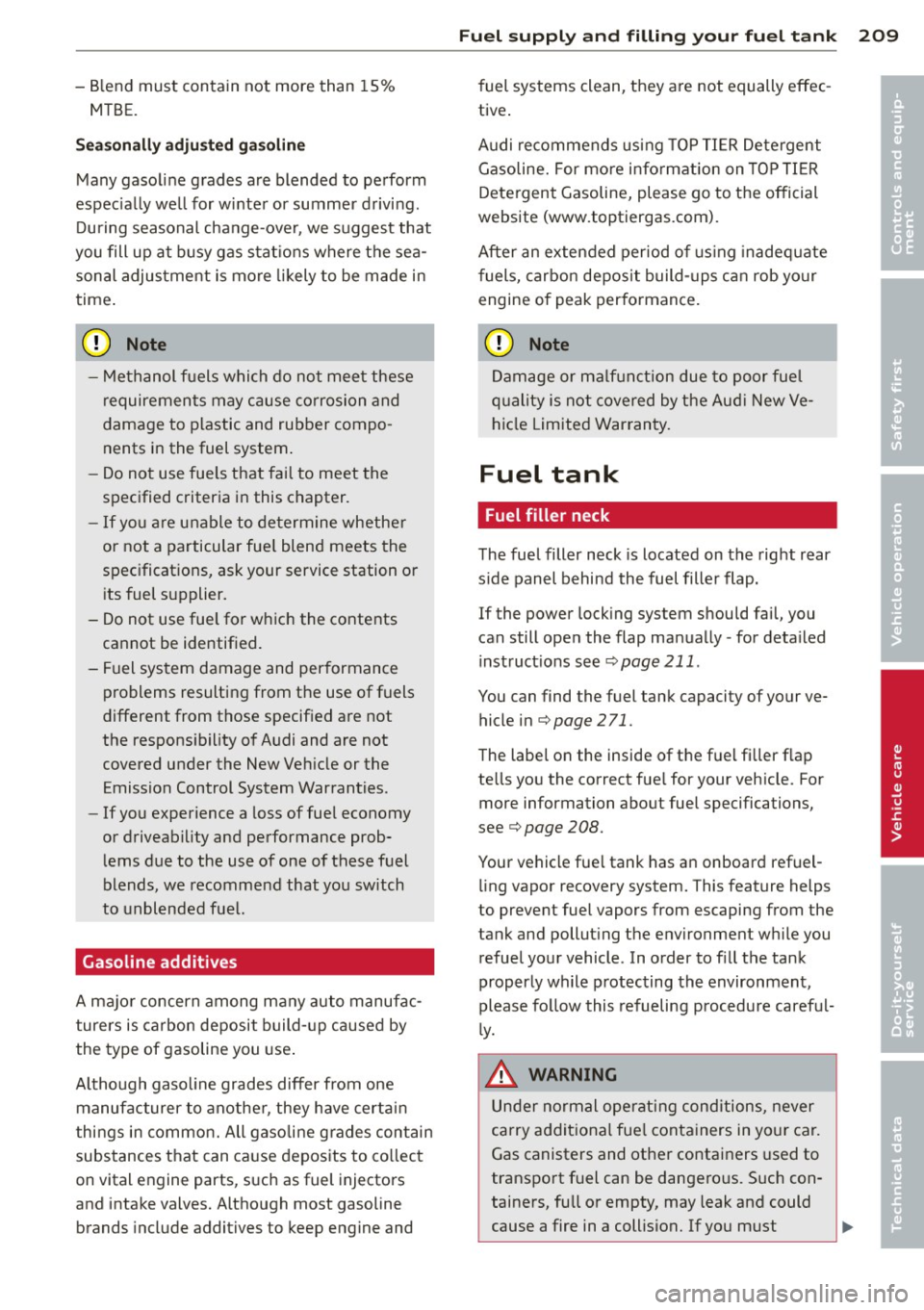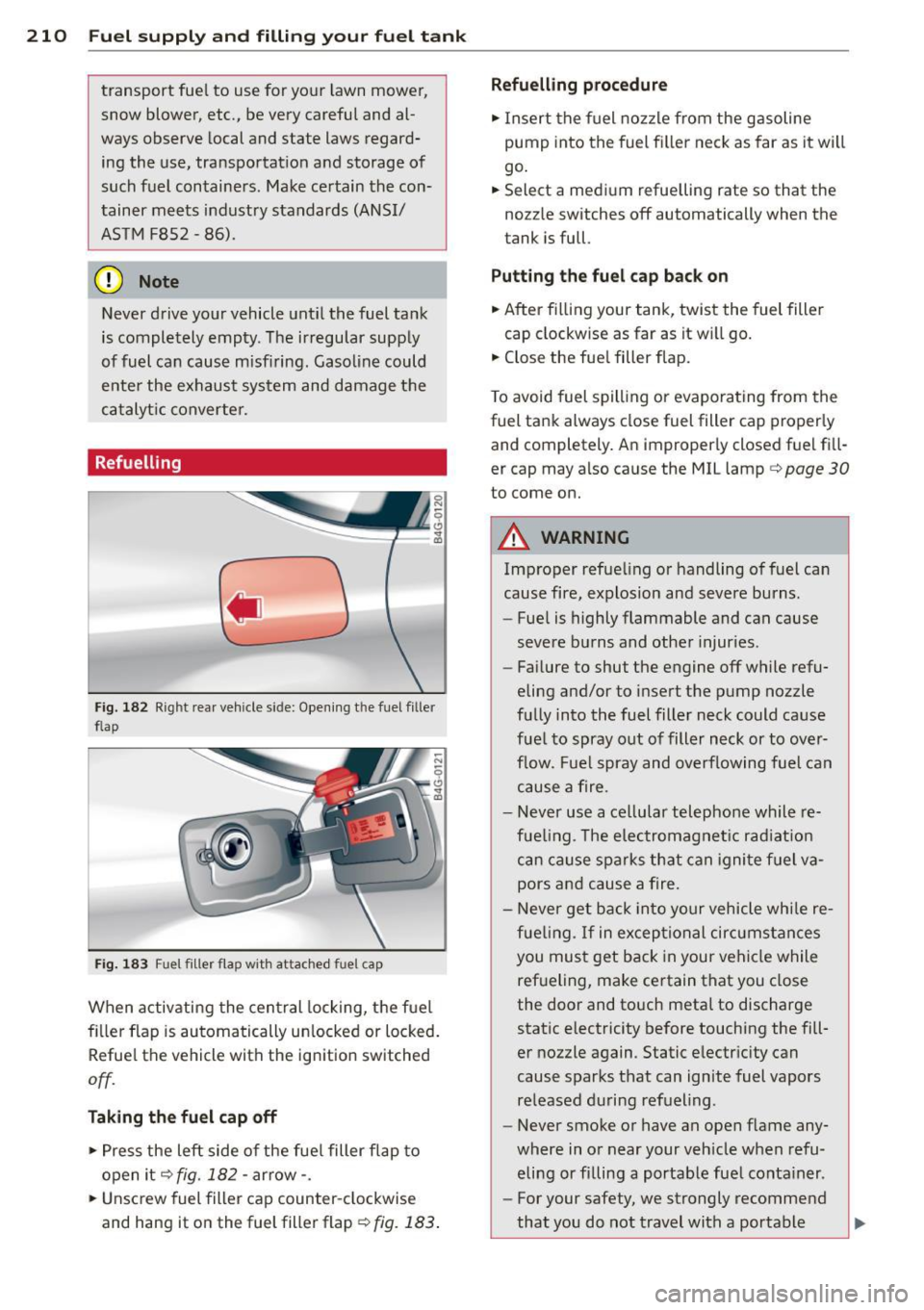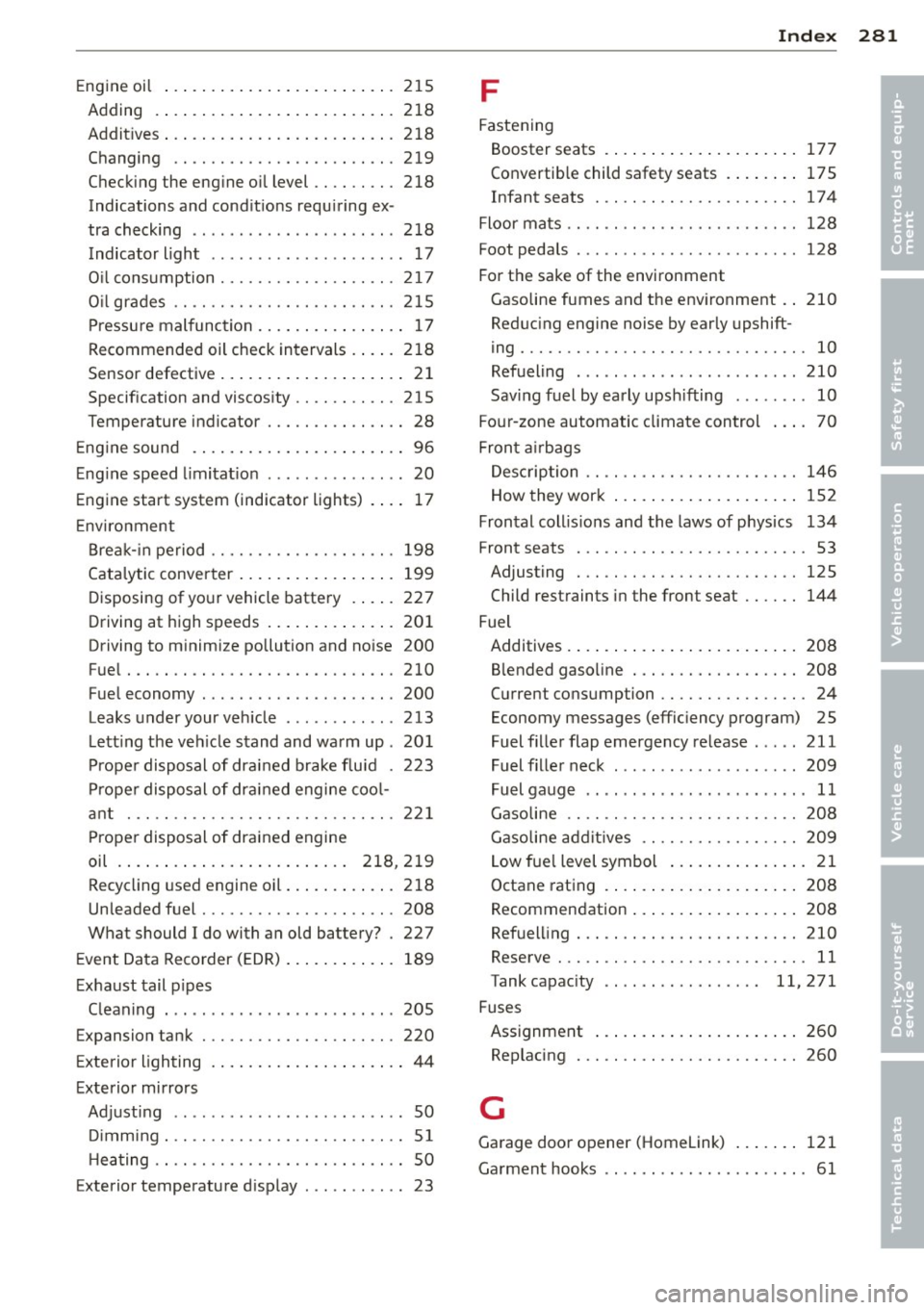2014 AUDI RS7 SPORTBACK open gas tank
[x] Cancel search: open gas tankPage 211 of 292

-Blend must contain not more than 15%
MTBE.
Seasonally adjusted gasoline
Many gasoline grades are blended to perform
espec ially we ll for winter or summer driving.
During seasonal change-over, we suggest that
you fill up at busy gas stat ions where the sea
sonal adjustment is more likely to be made in
time .
(D Note
-Methanol fuels which do not meet these
requirements may cause corrosion and
damage to plastic and rubber compo
nents in the fuel system .
- Do not use fue ls that fail to meet the
specified criter ia in this chapter.
- If you are unable to determine whether
or not a particular fue l blend meets the
specifications, ask your service station or
its fuel supp lier.
- Do not use fuel for which the contents
cannot be identified.
- Fuel system damage and performance
problems resulting from the use of fuels
different from those specified are not
the responsibility of Audi and are not
covered under the New Vehicle or the Emission Control System Warranties.
- If you experience a loss of fuel economy
or driveability and performance prob l ems due to the use of one of these fuel
blends, we recommend that you switch
to unblended fuel.
Gasoline additives
A major concern among many auto manufac
turers is carbon deposit build- up caused by
the type of gasoline you use.
Although gasoline grades differ from one manufacturer to another , they have certain
things in common. All gasoline grades contain
substances that can cause deposits to collect
on vital engine parts, such as fuel injectors
and intake valves. Although most gasoline brands include additives to keep engine and
Fuel supply and filling your fuel tank 209
fuel systems clean, they are not equally effec
tive .
A udi recommends using TOP TIER Detergent
Gasoline. For more info rmation on TOP TIER
Detergent Gasoline, please go to the official
website (www.toptiergas.com).
After an extended period of using inadeq uate
fuels, carbon deposit build-ups can rob your
engine of peak performance.
Q) Note
Damage or malf unct ion due to poor fue l
quality is not covered by the Aud i New Ve
hicle Limited Warranty.
Fuel tank
Fuel filler neck
The fuel filler neck is located on the right rear
side panel behind the fuel fille r flap.
If the power locking system should fail, you
can still open the flap manually -for deta iled
instruct ions see
c::;, page 211 .
You can find the fuel tank capacity of your ve
hicle in
c::;,page271.
The label on the inside of the fuel fi ller flap
tells you the correct fue l for your vehicle. For
more information about fuel specifications,
see
c::;, page 208.
Your vehicle fue l tank has an on board refuel
li ng vapor recovery system. This feature helps
to prevent fuel vapors from escaping from the
tank and polluting the environment while you refuel your vehicle . In order to fill the tank
properly while protecting the environment,
please fo llow this refueling procedure careful
ly.
_&. WARNING
Under normal operating conditions, never
carry additional fuel containers in your car.
Gas canisters and other containers used to
transport f uel can be dangero us. Such con
tainers, full or empty, may leak and could
cause a fire in a collision. If you must
•
•
Page 212 of 292

210 Fuel supply and filling your fuel tank
transport fuel to use for your lawn mower,
snow blower, etc., be very careful and al
ways observe local and state laws regard
ing the use, transportat ion and storage of
such fuel containers. Make certain the con
tainer meets industry standards (ANSI/
AS TM F852 -86) .
(D Note
Never drive your vehicle until the fuel tank
is completely empty. The irregular supply
of fuel can cause misfiring. Gasoline could
enter the exhaust system and damage the
catalyt ic converter.
Refuelling
Fig. 182 Right rear vehicle side: Opening the fuel filler
flap
Fig . 183 Fuel filler flap with attached fuel cap
When activating the central locking, the fuel
fi ller flap is automatically un locked or locked.
Refuel the vehicle with the ignition switched
off.
Taking the fuel cap off
• Press the left side of the fuel filler flap to
open it
q fig. 182 -arrow-.
• Unscrew fuel filler cap counter-clockwise
and hang it on the fuel filler flap
¢ fig. 183.
Refuelling procedure
• Insert the fuel nozzle from the gasoline
pump into the fuel filler neck as far as it will
go .
• Select a med ium refuelling rate so that the
nozzle switches off automatically when the
tank is full.
Putting the fuel cap back on
• After filling your tank, twist the fuel filter
cap clockwise as far as it w ill go.
• Close the fue l filler flap.
T o avoid fuel spilling or evaporating from the
fuel tank always close fuel filter cap properly
and completely. An improperly closed fuel fill
er cap may also cause the MIL lamp¢
page 30
to come on.
A WARNING
Improper refue ling or handling of fuel can
cause fire, explosion and severe burns.
- Fuel is highly flammable and can cause
severe burns and other injuries.
- Fai lure to shut the engine off while refu
eling and/or to insert the pump nozzle
fully into the fuel filter neck could cause
fuel to spray out of filler neck or to over
flow. Fuel spray and overflowing fuel can
cause a fire.
- Never use a ce llular telephone while re
fue ling. Th e electromagnet ic rad iat ion
can cause sparks that can ignite fuel va
pors and cause a fire.
- Never get back into your vehicle whi le re
fueling.
If in exceptional circumstan ces
you must get back in your vehicle while
refueling, make certain that you close
the door and touch metal to discharge
static electricity before touching the fill
er nozzle again. Static electricity can
cause sparks that can ignite fuel vapors
released during refueling.
- Never smoke or have an open flame any
where in or near your veh icle when refu
eling or filling a portable fuel conta iner.
- For your safety, we strongly recommend
that you do not travel with a portable
Page 283 of 292

Engine oi l ... .. .... ..... .. .. .. .. ... 215
Adding .... .... .. .... ... .. .. .. ... 218
Addit ives ... .... ...... ... .. .. .. .. . 2 18
Changing .. ............. .... .. ... 219
Checking the eng ine o il level .. .. .. .. . 218
Indications and cond it ions requ iring ex -
tra check ing ..... .. ...... .. .. .. .. . 218
I ndicator light . . . . . . . . . . . . . . . . . . . . . 17
O il consumption .......... .. .. .. .. . 217
O il gr ad es .. ............. .... .. ... 2 15
P ressure mal func tion ... ... .. .. .. .. .. 17
Recommended oil check intervals . ... . 21 8
Sensor defective . . . . . . . . . . . . . . . . . . . . 21
Specif ication and viscos ity . . . . . . . . . . . 215
Temperature indicator ..... .. .. .. .. .. 28
E ng ine sound . ... ...... ... .. .. .. .. .. 96
E ng ine speed limitat ion ...... ... ... ... 20
Engine start system (indicator lights) . ... 1 7
E nvi ro nment
B re ak -in period ........... .... .. .. . 198
Ca ta lytic converter ..... ... .. .. .. .. . 199
D isposing of yo ur vehicle battery . ... . 227
Driving at high speeds .. ... .. .. .. .. . 20 1
Driving to m inimize pollution and no ise 200
Fue l ..... .. .. .. ........... .. .. ... 210
F u el economy ... .... ... .. .. .. .. .. . 200
Leaks under your ve hicle ...... .. .... 213
L ett ing the veh icle stand and wa rm up . 20 1
Pr ope r disposal of dra ined brake flu id . 22 3
Pr ope r disposal of dra ined engine coo l-
a nt . .. .. .. ................. .. .. . 22 1
Pr ope r disposal of drained engine
oil . ..... .. .. ... .. ..... ... .. 218,2 19
Recycl ing used engine oil ... .. .. .. .. . 218
Unleaded f uel ............ .... .. ... 208
What should I do with an old battery? . 227
E vent Data Recorder (EDR) ... .. .. .. .. . 189
E xhaust tail p ipes
C leaning . .. ....... ...... .... .. .. . 205
Expansion tank ............ .... .. .. . 220
E xterior lighting . ... .... ... .. .. .... .. 44
E xterior mirrors
Ad justing ................ ... ... ... 50
D imming . .. ............. .... .. .... 51
H eating .. .. .. ........... .. .. .. .... 50
Exterior temperature d isplay ..... ... ... 23
Inde x 281
F
Fastening
Booster seats . . . . . . . . . . . . . . . . . . . . . 177
Convertib le child safety seats . ... .. .. 175
Infant seats . . . . . . . . . . . . . . . . . . . . . . 17 4
Floor ma ts .. .. .. .. .. .. ........... .. 128
Foot peda ls .... ... .. ..... .......... 128
Fo r th e sake of the environment
Gasoline fumes and the env ironment . . 210
Red ucing engine noise by early upshift -
ing ....... .. .. .. ................. . 10
Refueling . .. .. .... .......... ..... 210
Sav ing fuel by early upsh ifting ...... .. 10
Fo ur-zone automatic climate control ... . 70
Fron t air bags
D es cription . . . . . . . . . . . . . . . . . . . . . . . 146
How they wor k . . . . . . . . . . . . . . . . . . . . 152
Frontal coll is io ns and the laws of p hys ics 134
Front seats . . . . . . . . . . . . . . . . . . . . . . . . . 53
Adjusting . .. .. .. .. .. ........... .. 125
Child restraints in the fron t seat .... .. 144
Fuel Additives . ... .... .. . .. .. ..... ... .. 208
B lended gaso line ..... ............. 208
C u rrent consumption ........... .. .. . 24
Economy messages (effic iency program) 25
Fuel fil ler flap emergency re lease . .... 211
Fuel fille r neck ... .. ... ....... .... . 209
Fuel gauge . . . . . . . . . . . . . . . . . . . . . . . . 11
Gasoline .. .. .. .. ... ............ .. 208
Gasoline ad di tives .... ........... .. 209
L ow fue l level symbol . . . . . . . . . . . . . . . 21
Octane rat ing . ..... . .. .. ..... ... .. 208
Recommendation ... . .. .. ... ... .. .. 208
Ref uel ling ... .. ...... ............. 210
Reserve ... .. .. .. ... ............ .. . 11
Tank capac ity . . . . . . . . . . . . . . . . . 11,271
Fuses Ass ignment ..... .. . .. .. ..... ... .. 260
Rep lacing . .. .. .. ................. 260
G
Garage door opener (Homelink) ... .. .. 121
Ga rment hooks .. .. .. . .. .. ..... ... .. . 61
•
•